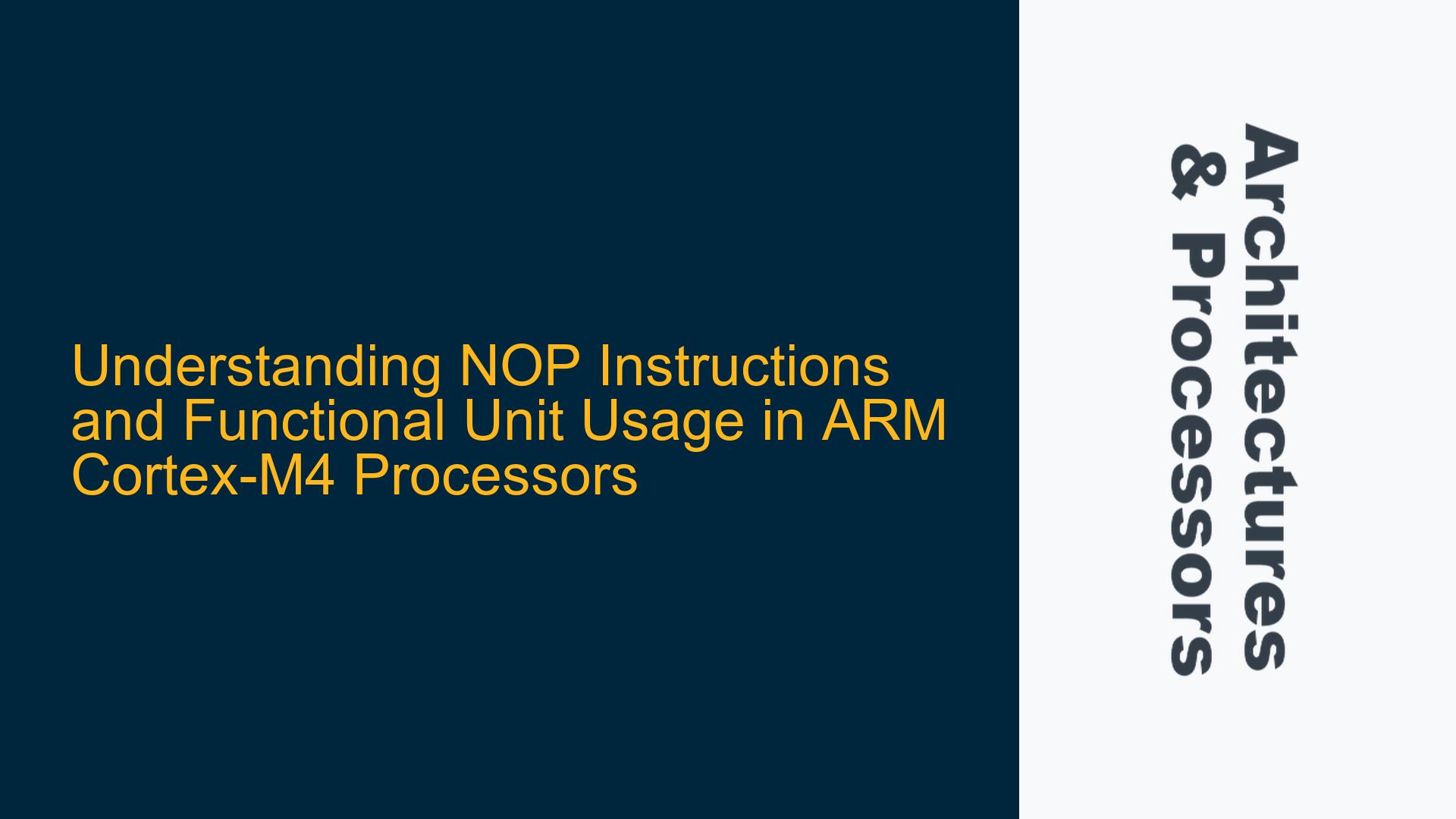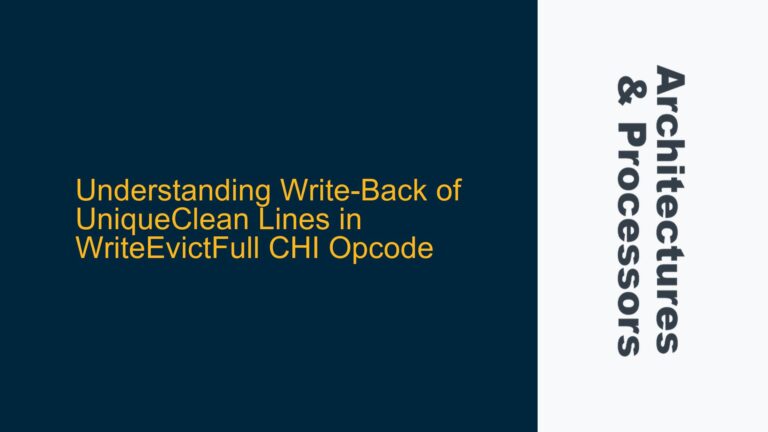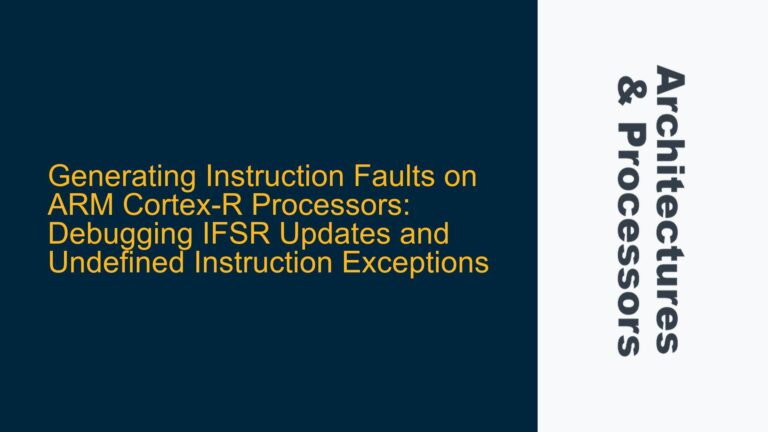NOP Instructions and Their Impact on Functional Unit Activation in ARM Cortex-M4
The ARM Cortex-M4 processor, like many modern embedded processors, is designed to execute instructions efficiently while managing power consumption and performance. One of the key aspects of understanding processor behavior is analyzing how instructions interact with the functional units within the processor. Functional units are the hardware components responsible for executing specific operations, such as arithmetic logic units (ALUs), floating-point units (FPUs), and load/store units. In this context, the NOP (No Operation) instruction is often discussed as a candidate for scenarios where the functional unit is not utilized. However, the behavior of NOP instructions and their impact on functional unit activation is nuanced and requires a detailed exploration.
The NOP instruction is typically used to introduce delays or align instruction pipelines, but its interaction with the functional unit is not always straightforward. In the ARM Cortex-M4, the NOP instruction is encoded as 0xBF00 in Thumb-2 instruction set, and it is designed to consume minimal resources. However, the processor’s internal activities, such as instruction fetching and decoding, continue even when a NOP is executed. This raises questions about whether the functional unit is truly inactive during a NOP instruction and how to measure its impact accurately.
To address these questions, we must first understand the architecture of the ARM Cortex-M4, the role of functional units, and the specific behavior of NOP instructions. This analysis will also explore alternative instructions or techniques that can be used to measure the activation and deactivation of functional units, providing a comprehensive guide for embedded systems engineers working with ARM processors.
Functional Unit Activation and the Role of NOP Instructions in ARM Cortex-M4
The ARM Cortex-M4 processor is based on the ARMv7-M architecture, which includes a variety of functional units designed to handle different types of operations. These functional units include the ALU for arithmetic and logical operations, the FPU for floating-point calculations, and the load/store unit for memory access. Each instruction executed by the processor interacts with one or more of these functional units, depending on the operation being performed.
The NOP instruction, as the name suggests, is intended to perform no operation. In older ARM architectures, such as ARM7TDMI, the NOP instruction was often implemented as a MOV instruction that moved a register’s value to itself (e.g., MOV R8, R8). This approach was used because there was no dedicated NOP instruction in the instruction set. However, starting with the ARM1176 and later architectures, including the Cortex-M series, a dedicated NOP instruction was introduced as part of the Thumb-2 technology. This instruction is encoded as 0xBF00 and is explicitly designed to consume minimal resources.
Despite its simplicity, the NOP instruction does not completely deactivate the functional units in the processor. While it does not perform any arithmetic, logical, or memory operations, the processor continues to fetch and decode subsequent instructions. This means that the instruction pipeline remains active, and the processor’s control logic continues to operate. Therefore, while the NOP instruction does not utilize the ALU, FPU, or load/store unit, it does not result in a complete deactivation of the processor’s functional units.
To measure the impact of functional unit activation and deactivation, it is essential to consider the processor’s overall activity during the execution of NOP instructions. This includes understanding the instruction pipeline, the role of the fetch and decode units, and the potential for power-saving modes that can reduce functional unit activity.
Measuring Functional Unit Activation and Deactivation in ARM Cortex-M4
To accurately measure the impact of functional unit activation and deactivation, embedded systems engineers must consider both the theoretical behavior of instructions and the practical implementation details of the ARM Cortex-M4 processor. The following steps outline a systematic approach to analyzing functional unit usage and identifying instructions that minimize functional unit activity.
Step 1: Understanding the Instruction Pipeline and Functional Units
The ARM Cortex-M4 processor uses a three-stage pipeline consisting of fetch, decode, and execute stages. During the fetch stage, the processor retrieves instructions from memory. In the decode stage, the instructions are decoded into control signals for the functional units. Finally, in the execute stage, the functional units perform the required operations.
When a NOP instruction is executed, the fetch and decode stages continue to operate, but the execute stage does not perform any meaningful operation. This means that while the ALU, FPU, and load/store unit are not actively performing calculations or memory accesses, the processor’s control logic and instruction pipeline remain active.
Step 2: Analyzing NOP Instruction Behavior
The NOP instruction in the ARM Cortex-M4 is encoded as 0xBF00 and is designed to consume minimal resources. However, as discussed earlier, it does not completely deactivate the functional units. To measure the impact of NOP instructions on functional unit activation, engineers can use performance counters and power measurement tools available in the Cortex-M4 processor.
Performance counters can be used to monitor the number of cycles spent in different stages of the pipeline, as well as the activity of specific functional units. By comparing the performance counter values during the execution of NOP instructions and other instructions, engineers can gain insights into the functional unit usage.
Power measurement tools, such as those provided by ARM’s Development Studio or third-party tools, can be used to measure the power consumption of the processor during the execution of NOP instructions. Since power consumption is directly related to the activity of functional units, these measurements can provide valuable information about the impact of NOP instructions on functional unit activation.
Step 3: Exploring Alternative Instructions and Techniques
While the NOP instruction is a useful tool for introducing delays or aligning instruction pipelines, it is not the only option for minimizing functional unit activity. Other instructions and techniques can be used to achieve similar results, depending on the specific requirements of the application.
One alternative is to use the WFI (Wait For Interrupt) instruction, which puts the processor into a low-power state until an interrupt occurs. During this state, most of the functional units are deactivated, resulting in significant power savings. However, the WFI instruction is not suitable for all scenarios, as it requires an interrupt to wake the processor.
Another option is to use the SEV (Send Event) instruction, which sends an event to other processors in a multi-core system. While this instruction does not directly impact functional unit activity, it can be used in conjunction with other techniques to manage processor resources more efficiently.
Step 4: Implementing Data Synchronization Barriers and Cache Management
In addition to using specific instructions, engineers can implement data synchronization barriers and cache management techniques to control functional unit activity. Data synchronization barriers, such as the DMB (Data Memory Barrier) and DSB (Data Synchronization Barrier) instructions, ensure that memory operations are completed before proceeding to the next instruction. These barriers can be used to manage the activity of the load/store unit and ensure that memory accesses are performed in the correct order.
Cache management techniques, such as cache invalidation and cleaning, can also be used to control the activity of the memory subsystem. By invalidating or cleaning specific cache lines, engineers can reduce the number of memory accesses and minimize the activity of the load/store unit.
Step 5: Practical Considerations and Best Practices
When working with NOP instructions and other techniques to manage functional unit activity, it is important to consider the practical implications for the overall system. For example, introducing too many NOP instructions can reduce the performance of the processor and increase power consumption, as the instruction pipeline remains active even when no meaningful work is being done.
To optimize the use of NOP instructions and other techniques, engineers should carefully analyze the requirements of their application and consider the trade-offs between performance, power consumption, and functional unit activity. In some cases, it may be more efficient to use a combination of instructions and techniques to achieve the desired results.
Conclusion
The NOP instruction in the ARM Cortex-M4 processor is a useful tool for introducing delays or aligning instruction pipelines, but it does not completely deactivate the functional units. To measure the impact of functional unit activation and deactivation, engineers can use performance counters, power measurement tools, and alternative instructions such as WFI and SEV. By implementing data synchronization barriers and cache management techniques, engineers can further control the activity of functional units and optimize the performance and power consumption of their embedded systems.
Understanding the behavior of NOP instructions and their impact on functional unit activation is essential for developing efficient and reliable embedded systems. By following the steps outlined in this guide, engineers can gain valuable insights into the operation of the ARM Cortex-M4 processor and make informed decisions about the use of NOP instructions and other techniques in their applications.






